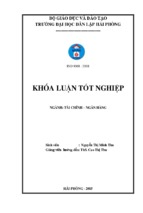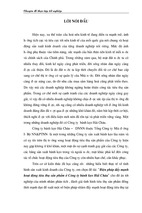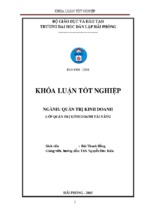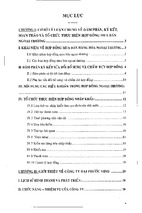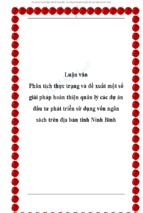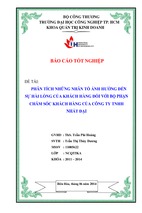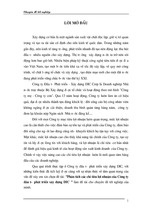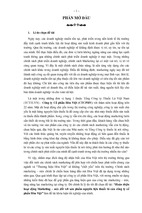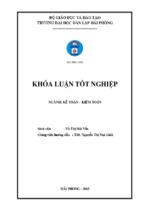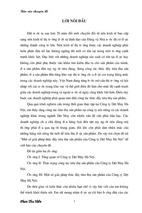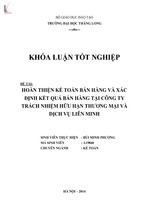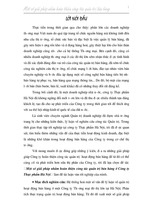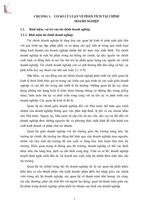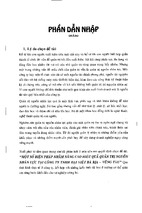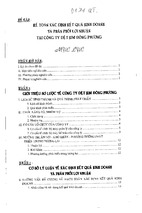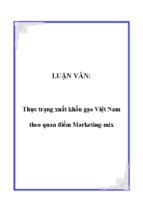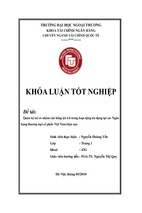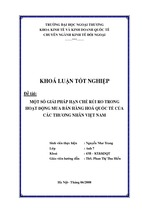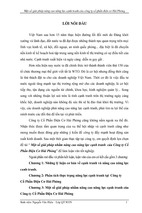J ÖNKÖPING I NTERNATIONAL B USINESS S CHOOL
JÖNKÖPING UNIVERSITY
IMPROVING INVENTORY
MANAGEMENT IN SMALL
BUSINESS
A CASE STUDY
Master Project in International Logistics and
Supply Chain
Management
Authors:
Lining Bai
Ying Zhong
Tutor:
Jens Hultman
Jönköping
2008-01
Master Thesis in International Logistics and Supply Chain Management
Title:
Improving Inventory Management in Small Business: A Case Study
Authors:
Lining Bai and Ying Zhong
Tutor:
Jens Hultman
Date:
2008-01
Subject terms:
Supply Chain Management, Inventory Management, Purchasing, IT,
Small Business.
Abstract
Introduction:
The growth of small business is fast and their impact on the economy is
becoming bigger.
How to manage the inventory effectively and efficiently often is a challenge for these
small
businesses. The study took place at HEM-SOL FORSALJNINGS AB, a company
involved
in gym sports equipment wholesale. For HEM-SOL two inventory problems,
stock-out
and overstock occur frequently. The company wants to improve its efficiency and is
con-
sidering a change in the inventory management.
Purpose:
The purpose of this study is to investigate the reasons behind the inventory
management
inefficiency in HEM-SOL, and then the proposed managerial suggestions will be
presented
to deal with the issues.
Method:
The study is considered as qualitative single-case study. Data collection is
mainly through
the interviews with the top manager and other staff involved in inventory control
operations. Secondary data is retrieved from the information system to provide the annual
purchasing and sales report about twenty items using a purposive sampling
approach. Data
analysis follows the theoretical framework.
Conclusion:
Small businesses have limited financial resources and bargaining power. Longdistance
suppliers, big fluctuation of demand and lack of formalized inventory control system
result
in HEM-SOL bad performance on inventory management. The authors analyze the
collected data and establish a formal inventory control system as the solution to improve
the
company’s inventory management.
1
Acknowledgement
We would like to give gratitude to the staff in HEM-SOL FORSALJNINGS
AB, who
spent time out of their busy schedules to take part in our research, especially:
Jan Östman,
General Manager of HEL-SOL FORSALJNINGS AB;
Helena Olsson Logistics & Purchasing Coordinator of HEL-SOL FORSALJNINGS AB.
They kindly gave us the opportunity to do this thesis project and provided us with suffi-
cient information.
And we also appreciate our thesis supervisor Jens Hultman for his support, tips and
guid-
ance given to us during the whole process of research.
……………………………………
…………………………………...
Lining Bai
Ying Zhong
January 2008, Jönköping
2
Table of content
Acknowledgement ........................................................................... 2
1
Introduction................................................................................. 6
1.1
1.2
1.3
1.4
1.5
1.6
2
Background ....................................................................................... 6
Problem Discussion........................................................................... 7
Research Questions .......................................................................... 7
Purpose ............................................................................................. 7
Delimitation........................................................................................ 8
Disposition ......................................................................................... 8
Theoretical Framework.............................................................. 9
2.1
Supply Chain Management (SCM) .................................................... 9
2.1.1 Inventory Management............................................................... 9
2.1.1.1 Challenge of Inventory Management.......................................................9
2.1.1.2 Demand Management ..........................................................................10
Demand Forecast ...............................................................................................10
Stock-out ............................................................................................................11
Safety Stock........................................................................................................11
2.1.1.3 Inventory Turns.....................................................................................11
2.1.1.4 Tradeoffs of Inventory ...........................................................................12
2.1.1.5 Inventory Carrying Costs.......................................................................13
2.1.1.6 Classification of Inventory .....................................................................14
2.1.1.7 Inventory Control Systems ....................................................................15
ABC Analysis .....................................................................................................15
When to Order? ..................................................................................................17
How much to order? ...........................................................................................19
2.1.1.8 Warehousing ........................................................................................21
Three Basic Functions of Warehouse.................................................................21
Types of Warehouse ...........................................................................................21
Warehouse Layout .............................................................................................22
Warehouse Management System (WMS)...........................................................22
2.1.2
Purchasing Management ......................................................... 23
2.1.3
IT Application in SCM............................................................... 24
2.1.2.1
2.1.2.2
2.1.3.1
2.1.3.2
2.1.3.3
2.1.3.4
2.2
3
The major purchasing decision processes.............................................23
Supplier relationship management ........................................................24
The Role of IT in SCM ..........................................................................24
IT goals in SCM ....................................................................................25
Integrating Supply Chain IT...................................................................25
ERP Information System in Organizations.............................................26
Small Business and SCM ................................................................ 26
2.2.1 Definitions ................................................................................ 26
2.2.2 Characteristics, Strengths and Weaknesses of SMEs ............. 27
2.2.3 Small Business Embracing SCM:Pros and Cons .................. 28
Methodology ............................................................................. 30
3.1
3.2
3.3
Generating the Research Topic....................................................... 30
Deciding the Research Approach .................................................... 30
Choosing the Appropriate Research Strategies............................... 31
3.3.1 Case Study Strategy ................................................................ 31
3.3.2 CrossSectional Studies ........................................................... 32
3.3.3 Exploratory, Descriptive and Explanatory Studies.................... 32
3.4
Qualitative or Quantitative Research ............................................... 33
3
4
3.5
Data Collection Methods.................................................................. 34
3.6
3.7
Analyzing Qualitative Data............................................................... 34
Credibility/ Reliability........................................................................ 35
Empirical findings .................................................................... 36
4.1
4.2
4.3
4.4
Company Profile .............................................................................. 36
Organizational structure................................................................... 36
Supplier ........................................................................................... 37
Business Operation Process ........................................................... 38
4.4.1 Inhouse business operations .................................................. 38
4.4.2 Outsourced business functions ................................................ 38
4.4.2.1
4.4.2.2
4.5
4.6
5
Information System.......................................................................... 38
Perceived Problems......................................................................... 39
Analysis..................................................................................... 40
5.1
5.2
5.3
Inventory Turnover .......................................................................... 40
Inventory Tradeoffs......................................................................... 40
Inventory Control Systems............................................................... 41
5.3.1 ABC Analysis ........................................................................... 41
5.3.2 When to order? ........................................................................ 43
5.3.2.1
5.3.2.2
Continuous Review...............................................................................44
Periodic Review....................................................................................46
5.3.3.1
5.3.3.2
EOQ .....................................................................................................48
Alternative Order Quantity approach .....................................................48
5.3.3
5.4
5.5
How much to order?................................................................. 48
Inventory Carrying Cost................................................................... 49
Warehouse ...................................................................................... 49
5.5.1 Warehouse Layout ................................................................... 49
5.5.1.1
5.5.1.2
5.5.1.3
5.6
5.7
6
Location labeling on the warehouse floor ..............................................49
Zone identification.................................................................................50
Rack identification.................................................................................51
5.5.2 Warehouse Management System (WMS) ................................ 52
Purchasing....................................................................................... 53
Information System.......................................................................... 53
Conclusion ................................................................................ 55
6.1
6.2
6.3
7
Inbound Logistics..................................................................................38
Outbound logistics ...............................................................................38
Theoretical Conclusions .................................................................. 55
Practical Conclusions ...................................................................... 55
Criticism to the Study....................................................................... 56
Reference .................................................................................. 57
4
Figures
Figure 2. 1 Saving inventory dol ars by inventory turns .................................... 12
Figure 2. 2 What costs go into inventory carrying costs? ................................. 13
Figure 2. 3 Typical representation of ABC analysis.......................................... 16
Figure 2. 4 Inventory level in a continuous review model ................................. 17
Figure 2. 5 ROP with safety stock .................................................................... 18
Figure 2. 6 Inventory level in a periodic review model ...................................... 19
Figure 2. 7 The example of material’s barcode scans. ..................................... 23
Figure 2. 8 The cost of unsuccessful supplier relationships ............................. 24
Figure 4. 1 Organizational Structure of HEMSOL............................................ 37
Figure 5. 1 Periodic review system for items A................................................. 47
Figure 5. 2 Periodic review system for items B................................................ 47
Figure 5. 3 Periodic review for items C............................................................ 47
Figure 5. 4 The example of column grid label................................................... 50
Figure 5. 5 HEMSOL’s warehouse.................................................................. 50
Figure 5. 6 The example of shingle of zone...................................................... 51
Figure 5. 7 Unclear item location guide ........................................................... 51
Figure 5. 8 The example of item location guide................................................ 52
Figure 5. 9 Incorrect rack label ........................................................................ 52
Figure 5. 10 There is no rack label for item location......................................... 52
Figure 5. 11 Rubber plates in HEMSOL’s warehouse..................................... 53
Tables
Table 2. 1 EU definition of SME........................................................................ 27
Table 2. 2 Characteristics, strengths and weaknesses of SMEs ...................... 28
Table 5. 1 Determination of dollar value ........................................................... 42
Table 5. 2 Ranking of items, using a 204040% ABC classification ................ 43
Table 5. 3 Twenty items monthly demand in volume and ratio for 2007........... 44
Table 5. 4 ROP level & order quantity of 20 items............................................ 45
Appendices
Appendix 1 Annual sales report for twenty items in 2007............................... 60
Appendix 2 Twenty items’ annual demand analysis....................................... 70
Appendix 3 Each item’s annual demand analysis for A items ........................ 70
Appendix 4 Each item’s annual demand analysis for B items ........................ 71
Appendix 5 Each item’s annual demand analysis for C items ........................ 72
Appendix 6 – Proposed Interview Questions for HEMSOL ............................. 73
5
1
Introduction
The first chapter gives an introduction of the background of this study. Furthermore it gives an explanation
of company’s problems. Then the research questions and purpose of this thesis are presented. The chapter
ends with the delimitation of this study and the outline of fol owing chapters.
1.1
Background
The American Production and Inventory Control Society (APICS) define inventory management as the branch of business management concerned with planning and
controlling
inventories (Toomey, 2000). Inventory management is a critical management issue for
most
companies – large companies, medium-sized companies, and small companies.
Logistics is all about managing inventory, whether the inventory is moving or
staying,
whether it is in a raw state, in manufacturing, or finished goods (Goldsby &
Martichenko,
2005). Logistics and inventory management are embedded in each other and
tied up closely.
The “Bill of ‘Rights’” that logistics professionals often repeat is to deliver the
right product
to the right place, at the right time, in the right quantity and condition, and at the
right cost
(Goldsby et al., 2005). To make it happen, effective inventory management is a
cornerstone.
Inventory management also becomes a fundamental part of supply chain
management
(SCM) now. A lot of research in SCM over the last two decades can be
characterized as socalled “multi-echelon inventory theory” (Quayle, 2003). SCM has in recent
years become
an important way to enhance the company’s competitive strength and therefore
an important issue for most companies. According to Lam and Postle (2006), a summary
definition
of the supply chain can be stated as:
All the activities involved in delivering a product from raw material through to the customer including
sourcing raw materials and parts, manufacturing and assembly, warehousing and inventory tracking,
order entry and order management, distribution across all channels, delivery to the customer and the information systems necessary to monitor all of these activities.
Supply chain management coordinates and integrates all of these activities into
a seamless
process. During the process, inventory holding and warehousing play an
important role in
modern supply chains. A survey of logistics costs in Europe identified the cost
of inventory
as being 13 per cent of total logistics costs, whilst warehousing accounted for a
further 24
per cent (European Logistics Association/AT Kearney, 2004). As well as being
significant
in cost terms, they are important in terms of customer service, with product
availability being a key service metric and warehousing being critical to the success or
failure of many
supply chains (Frazelle, 2002).
At Present the growth of small businesses and their impact on the entire
economy is becoming clear (Chapman, Ettkin & Helms, 2000). Based on
The European
Observatory for
SMEs-Fifth Annual Report (ENSR, 2004), more than 99% of the total number of
enterprises
in all EU countries is small and medium-sized enterprise (SME). In Sweden, for
example,
SMEs contribute 99.79% of all enterprises and they provide 96 percent of all
employment.
The average employment size for these SMEs is around 7 people. And SMEs
account for
approximately 50% to the UK gross domestic product and nearly 70% of
employment
(CBI, 2000; cited in Quayle, 2003). SMEs obviously become a vital part of
national economy.
6
Many large companies have saved millions of dol ars in costs and
decreased inventories
while improving efficiency and customer satisfaction through various SCM
techniques
(Chapman et al., 2000). But Welsh and White (1981) argue that the very size of small
businesses generates a special condition-referred to as resource poverty-that distinguishes
them
from the big businesses and requires some very different management
approaches. This
statement deviates from the traditional assumption that small businesses
should use similar
management principles as big businesses, only on a smaller scale (Welsh et al., 1981).
Many
SCM techniques and systems are too complex and expensive to implement for
small busi-
ness. Then one question comes up. Can SCM work for small businesses, with attention
fo-
cused on inventory management?
1.2
Problem Discussion
Effective inventory flow management in supply chains is one of the key factors for
success.
The challenge in managing inventory is to balance the supply of inventory with
demand. A
company would ideally want to have enough inventories to satisfy the demands of its
customers-no lost sales due to inventory stock-outs. On the other hand, the company does
not
want to have too much inventory staying on hand because of the cost of
carrying inventory.
Enough but not too much is the ultimate objective (Coyle, Bardi & Langley,
2003).
The inventory investment for a small business takes up a big percentage of the total
budget,
yet inventory control is one of the most neglected management areas in small
firms. Many
small firms have an excessive amount of cash tied up to accumulation of
inventory sitting
for a long period because of the slack inventory management or inability to
control the inventory efficiently. Poor inventory management translates directly into
strains on a company’s cash flow.
The studied company, HEL-SOL FORSALJNINGS AB (named briefly as HEMSOL in
text below) works in a niche market distributing the sports equipments
to its customers.
The company has difficulty in matching its supply with the customer demand
efficiently,
which means both stock-out of inventory and excess inventory occur in the
business. The
management problem has affected negatively their profitability mainly due to
the existence
of excess stock. It is considered that the problem results from insufficient
control over inventory and volatile demand for each product on a monthly base. To get a
reliable forecast
of the demand is not easy task in the wholesaling industry because of being
unable to estimate the right quantity of demand during a specific period for each product.
Another reason is that the lead-time of most products is long, about three months at the
longest.
1.3
Research Questions
The research question for this thesis project is listed below:
How can inventory management concepts, principles and techniques
be applied, or
further adapted to improve the inventory management in HEM-SOL?
1.4
Purpose
The purpose of this thesis project is to investigate and identify the reasons
behind the inefficient inventory management in HEM-SOL. Then the authors try to
propose feasible
managerial suggestions to improve the company’s inventory management
through our own
7
analysis, after examining the relevant theories and understanding the business
operational
practice of HEM-SOL.
1.5
Delimitation
Due to the limitation of time, it is impossible for the authors to make a longitudinal
study,
in which the implementation result of the proposed inventory control system can be
ob-
served and verified. And this harms the credibility of the study to some extent.
The case study scope is limited to the internal inventory management of HEM-SOL,
not
reaching out into the other actors in the supply chain network. In other words, the
interaction among the actors in the network in terms of inventory management is excluded.
And
from the SCM perspective, the contribution of the study is reduced.
1.6
Disposition
Chapter 1 The first chapter gives an introduction of the background of this study. Furthermore it gives an explanation of company’s problems. Then the
research
questions and purpose of this thesis are presented. The chapter ends with
the
delimitation of this study and the outline of following chapters.
Chapter 2 This chapter will explore the different theories and models that are related
to
the subject of this thesis and can be used for the analysis.
Chapter 3 In this chapter, the authors will examine different research methods and
pre-
sent what methods are applied to this thesis.
Chapter 4
The authors will present their empirical findings about business practice
of the
studied company and the major issues that needs to be addressed in their
in-
ventory management.
Chapter 5
The authors will conduct the analysis guided by theoretical
framework. The
analysis part is based on our empirical findings. Furthermore, the authors
will
present their suggestions upon the problems identified.
Chapter 6
In this chapter, the authors will present the conclusion about the whole
thesis
and summarize the implications of the research.
8
2
Theoretical Framework
This chapter will explore the different theories and models that are related to the subject of this thesis and
can be used for the analysis.
2.1
Supply Chain Management (SCM)
The term “supply chain management” has become a popular buzzword,
probably first used
by consultants in the late 1980s and then analyzed by the academic community in the
1990s
(Burt, Dobler & Starling, 2003).
Supply chain management is a set of approaches utilized to effectively integrate
suppliers,
manufacturers, logistics, and customers for improving the long-term performance
of the
individual companies and the supply chain as a whole (Chopra and Meindl, 2001).
Supply
chain management includes the link between upstream (such as supply and
manufacturing),
and downstream (such as logistics and distribution) value chain entities. Successful
supply
chain management requires the integration of these value chain entities to create
cooperative and collaborative environments that facilitate information exchanges,
materials and
cash flows (Kukalis, 1989).
2.1.1
Inventory Management
Effective inventory management is essential in the operation of any business
(Bassin, 1990).
Hakansson and Persson (2004) identifies three different trends in the
development of logistics solutions within industry, one trend is concerned with the increased
integration of logistics activities beyond organization boundaries with an aim to reduce cost
items such as
capital costs for inventory and handling costs of flows.
Inventory as an asset on the balance sheet of companies has taken on increased
importance
because many companies are applying the strategy of reducing their
investment in fixed assets, like plants, warehouses, equipment and machinery, and so on, which even
highlights
the significance of reducing inventory (Coyle et al., 2003).
Changes in inventory levels affect return on assets (ROA), which is an
important financial
parameter from an internal and external perspective. Reducing inventory
usually improves
ROA, and vice versa if inventory goes up without offsetting increases in
revenue (Coyle et
al., 2003).
2.1.1.1
Challenge of Inventory Management
The wholesalers and retailers that are major actors involved in
downstream distribution
channels face a special challenge in keeping inventory at reasonable levels due
to the difficulty of forecasting demand and expectations of customers about product
availability
(Coyle et al., 2003). The challenge grows even bigger when we think about the
diversity of
products in terms of their color/design, package type, size and so on. To further
explain
the problem, we assume there is an accurate demand forecast; however, the
aggregate demand needs to be broken down by various specifications of the product into
sub-total demand forecast to guide the stock keeping units (SKUs) in the company in order
to fulfill
the final customer’s order. But the sub-total demand forecasts could be diverse,
reaching
dozens, hundreds, or even thousands of categories; in that case, they become
truly difficult,
complex and time-consuming.
9
The difficulty of forecasting demands accurately naturally results in two
problems, which
are in opposite extreme, overstock and stock-out of inventory. As companies
strive to
avoid lost sales from stock-out of inventory, there is a tendency to overstock.
Nevertheless,
because keeping inventory is costly which definitely reduces the profit margin,
companies
try to reduce the inventory level, so appears the tendency to stock-out of inventory. We
can
get an overview of inventory management dilemma, where two opposing
powers keep pulling the inventory towards their own direction. It is hard to balance the two powers all
the
time and station the inventory at the right level constantly.
2.1.1.2
Demand Management
Demand management may
be thought of as “focused efforts to estimate and manage customers’ demand, with the intention of using this information to shape operating
decision.”
(Blackwell & Blackwell, 1999; cited in Coyle et al., 2003)
Independent and Dependent Demand
Independent demand is what whose usage is based on external market requirements
rather
than related to other items’ demand. The market demand for consumer goods is a
typical
example of independent demand. Dependent demand is determined by the
requirements of
other items in the manufacturing process. The requirement of components or
parts is
based on the demand for the finished products (Toomey, 2000).
The inventory corresponds to independent demand is called distribution
inventory/ finished product inventory, while dependent demand inventory is known as
manufacturing
inventory/raw material inventory and work-in-process (WIP) inventory (SimchiLevi,
Kaminsky & Simchi-Levi, 2004; Toomey, 2000).
Inventory is kept to meet demand, in light of dependent demand and independent
demand,
different approaches to managing inventory should be applied to align inventory
supply
with demand. Just-in-Time (JIT) approach and Materials Requirements Planning
(MRP)
system are typically associated with managing manufacturing inventory to serve
dependent
demand. Cross-docking is a typical approach for managing distribution
inventory efficiently.
Nevertheless, Vendor-managed-inventory (VMI) approach is applicable both for
manufacturing inventory and distribution inventory.
Demand Forecast
Sufficient data result in more effective forecasts. The traditional way to
forecast demand is
to refer to the historical record of demand. All forecasting techniques are
characterized by
the fact that the more data are observed, the more we modify the estimates of
the average
demand and demand variability, and the more accurate these predictions can
be (SimchiLevi et al., 2004).
Of course, forecasts are never completely accurate. Indeed, the following rules
of forecasting hold (Nahmias, 1997; cited in Simchi-Levi et al., 2004):
1.
The forecast is always wrong.
It is very unlikely that actual demand will exactly equal
forecast demand.
2.
The longer the forecast horizon, the worse is the forecast.
A forecast of demand far in the future
is likely to be less accurate than a forecast of near-future demand.
3.
Aggregate forecasts are more accurate.
10
Stock-out
If stock-out occurs, different scenarios will happen. Subject to distribution
inventory stockout or manufacturing inventory stock-out, the impact on the supplier and the customer
is
different in terms of extent and scale, i.e. the impact is greater and more serious for
one
party than the other one. So the attitude toward stock-out varies accordingly. For
instance,
if there is a manufacturing inventory stock-out in the manufacturing companies like
Ford
and Toyota, the result is critical. The production line will be shut down and startup
costs
are very high. Hence such stock-out is prohibited. In case of distribution inventory
stockout, the impact on the customer is usually not big and serious, e.g. it is not a big deal
when
consumers encounter such a stock-out, therefore their counterparts-the suppliers,
such as
wholesalers and retailers, tolerate stock-outs.
When a supplier is unable to satisfy demand with available inventory, one of four
events
may occur: (1) the customer waits until the new replenishment arrives; (2) the
customer
back orders the product; (3) the sale is lost; (4) the customer is lost (Coyle et al.,
2003). For
most companies, the four results are listed from best to worst in terms of the
impact.
Safety Stock
According to Toomey (2000), safety stock is one kind of inventory which can
protect
against fluctuations in demand or supply. And he also indicated that
‘the quantity of
safety
stock is built into the reordering system’s calculation in a manner that the inventory is not planned for con-
(Toomey, 2000, p.47) Because of the situation of
uncertainty in demand or delays in lead time or inadequate delivery, the
company needs a
small amount of safety stock on hand. In other words, the basic function of
safety stock is
to avoid stock-outs.
sumption under normal (perfect) circumstances.’
Another reason for setting safety stock is it could affect customer service level.
When the
actual order quantity from the customer is more than prediction, the safety
stock needs to
be held to avoid customer service problems (Krajewski & Ritzman, 2002). But
Bloomberg
et al. (2002) argued that the customer service levels vary by industries which
mean the customer acceptance for stock-out is different.
The setting of safety stock will base on the trade off between service level and
inventory
investment. The quantity of safety stock should cover more than normal
demand during
the replenishment lead time. There are some parameters that should be
considered when
calculating the suitable quantity of safety stock, such as recent demand needs,
lead time and
the target service level (Krajewski et al., 2002).
2.1.1.3
Inventory Turns
Inventory turns indicates the number of times per year the companies such as
retailers and
manufacturers are able to sell off or use up their complete inventory of raw
materials or
finished goods (Coyle et al., 2003).
To maximize sales with the least amount of inventory, the company
should try to meet
demands by ordering smaller quantities more frequently from the suppliers,
thus achieving
more inventory turns, which refer to the annual number of times that
average inventory
sells (Goldsby et al., 2005). The inventory turns can be expressed
mathematically as:
Inventory turns = Sales volume at cost/Value of average inventory
11
- Xem thêm -

